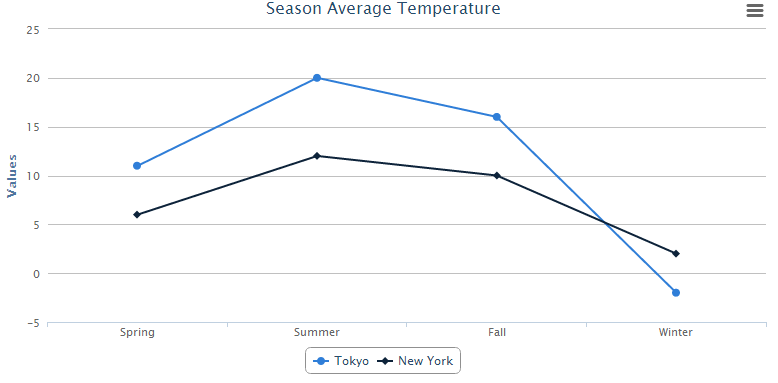Create your first ZK Charts"
From Documentation
Raymondchao (talk | contribs) |
Raymondchao (talk | contribs) |
||
| Line 7: | Line 7: | ||
First, declare a chart component in a ZUML document. Assign <tt>type</tt> and <tt>title</tt> properties to it. | First, declare a chart component in a ZUML document. Assign <tt>type</tt> and <tt>title</tt> properties to it. | ||
<source lang="xml"> | <source lang="xml"> | ||
| − | <window apply="ChartComposer"> | + | <window apply="ChartComposer"> |
| − | + | <charts id="chart" type="line" title="Season Average Temperature" /> | |
| − | </window> | + | </window> |
</source> | </source> | ||
| − | + | ||
| − | Then | + | Then specify chart data with model in the composer: |
<source lang="java"> | <source lang="java"> | ||
| − | + | public class ChartComposer extends SelectorComposer<Window> { | |
| − | |||
| − | + | @Wire | |
| − | + | Charts chart; | |
| − | + | ||
| − | + | public void doAfterCompose(Window comp) throws Exception { | |
| − | + | super.doAfterCompose(comp); | |
| − | |||
| − | |||
| − | |||
| − | |||
| − | |||
| − | + | CategoryModel model = new SimpleCategoryModel(); | |
| − | |||
| − | + | model.setValue("Tokyo", "Spring", new Integer(11)); | |
| − | + | model.setValue("Tokyo", "Summer", new Integer(20)); | |
| − | + | model.setValue("Tokyo", "Fall", new Integer(16)); | |
| − | + | model.setValue("Tokyo", "Winter", new Integer(9)); | |
| − | + | model.setValue("New York", "Spring", new Integer(6)); | |
| − | + | model.setValue("New York", "Summer", new Integer(14)); | |
| − | + | model.setValue("New York", "Fall", new Integer(8)); | |
| − | + | model.setValue("New York", "Winter", new Integer(2)); | |
| − | + | chart.setModel(model); | |
| + | } | ||
| + | } | ||
</source> | </source> | ||
| + | |||
| + | After that, you can obtain an amazing chart to visualize your data. | ||
| + | |||
| + | [[File:FirstChart.png]] | ||
{{ZKChartsEssentialsPageFooter}} | {{ZKChartsEssentialsPageFooter}} | ||
Revision as of 06:44, 5 March 2014
In the section we will show how to create your first ZK Charts component step by step.
First, declare a chart component in a ZUML document. Assign type and title properties to it.
<window apply="ChartComposer">
<charts id="chart" type="line" title="Season Average Temperature" />
</window>
Then specify chart data with model in the composer:
public class ChartComposer extends SelectorComposer<Window> {
@Wire
Charts chart;
public void doAfterCompose(Window comp) throws Exception {
super.doAfterCompose(comp);
CategoryModel model = new SimpleCategoryModel();
model.setValue("Tokyo", "Spring", new Integer(11));
model.setValue("Tokyo", "Summer", new Integer(20));
model.setValue("Tokyo", "Fall", new Integer(16));
model.setValue("Tokyo", "Winter", new Integer(9));
model.setValue("New York", "Spring", new Integer(6));
model.setValue("New York", "Summer", new Integer(14));
model.setValue("New York", "Fall", new Integer(8));
model.setValue("New York", "Winter", new Integer(2));
chart.setModel(model);
}
}
After that, you can obtain an amazing chart to visualize your data.
< Get Complete Source Code of This Book >
